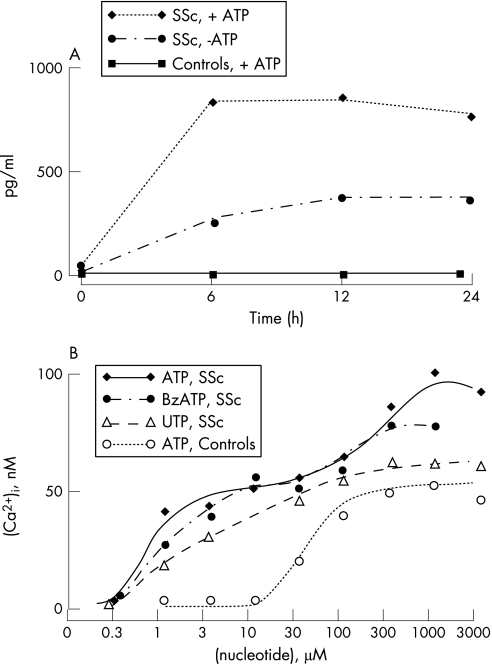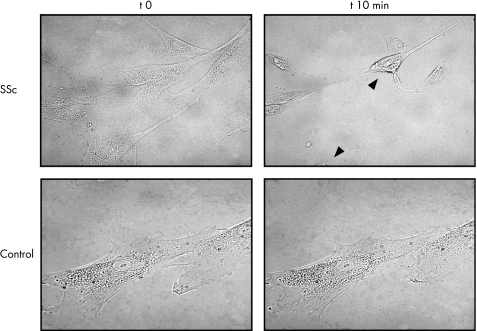Systemic sclerosis (SSc) is an autoimmune disease characterised by an excessive production of collagen and other constituents of the extracellular matrix in the skin, lung and other internal organs, by damage of the microvascular endothelium, and dysregulation of cytokine secretion.1,2,3 Recent studies show that extracellular nucleotides trigger cytoplasmic Ca2+ increases ([Ca2+]i), morphological changes and cytokine secretion in human fibroblasts.4 Nucleotides are released in response to traumas or inflammation, thus they may also affect fibroblast responses in scleroderma.5
We investigated intracellular second‐messenger generation, cytokine secretion and morphological changes in involved, non‐atrophic skin biopsies from five patients with the diffuse form of SSc.6 Fibroblasts from patients with SSc had a high rate of spontaneous interleukin (IL)‐6 release, which was further enhanced by stimulation with ATP (fig 1A). Changes in intracellular ion homeostasis ([Ca2+]i) and plasma membrane potential occurred at much lower ATP concentrations in fibroblasts from patients with SSc than in those from healthy controls (fig 1B). Analysis of Ca2+ influx versus Ca2+ release showed that both processes occurred at lower ATP concentrations in SSc fibroblasts. Finally, ATP‐stimulated fibroblasts from patients with SSc underwent morphological alterations that did not occur in fibroblasts from healthy controls (fig 2). As expected from these functional responses, SSC fibroblasts expressed mRNA for several P2 receptors: P2Y1, P2Y2, P2Y4, P2Y6, P2X3, P2X4 and P2X7.
Figure 1 Fibroblasts from patients with SSc are hypersensitive to stimulation with extracellular ATP. (A) Fibroblasts from healthy controls and patients with SSc were placed in 24‐well plates at a concentration of 4×105/ml in a volume of 0.5 ml. ATP was added at a concentration of 1 mmol/l. At the end of the incubation, supernatants were assayed for IL‐6 content by ELISA. (B) Fibroblasts were layered onto glass coverslips, loaded with Fura‐2/AM and transferred to a fluorimeter cuvette. After 5 minutes, nucleotides were added and peak [Ca2+]i over basal measured. For other experimental details see Solini et al.4
Figure 2 ATP causes cell shrinkage and rounding in SSc but not in control fibroblasts. Cells were seeded in DMEM onto 24 mm round glass coverslips and incubated for 24 h. Coverslips were then transferred to the thermostatically controlled stage of a Nikon Eclipse T300 microscope equipped with a back‐illuminated CCD camera. ATP was added at a concentration of 3 mmol/l.
The ability of ATP to trigger release of IL‐6 in the absence of priming with bacterial products (eg, lipopolysaccharide) suggests that SSc fibroblasts are in a pre‐activated state, possibly because of increased local ATP concentrations, and that ATP might be a modulator of the tissue microenvironment in SSc.7 These data support the hypothesis of altered P2R signalling in SSc, and suggest a potential role for P2 receptors as therapeutic targets. Selective P2Y12 blockers (clopidogrel) are mainly used as anti‐thrombotic therapy, and inhibitors of other P2X receptors (e.g. P2X7) are being considered for the treatment of inflammatory diseases.8 Blockers of the P2Y12 receptor may also be useful in inflammation, as recent data by Angiolillo et al show that in diabetes with associated coronary artery disease, P2Y12 inhibition also has anti‐inflammatory effects.9
Taken together, these data suggest a potential therapeutic role for P2 antagonists in patients with SSc, not only for their anti‐thrombotic and anti‐inflammatory properties, but also for a possible modulatory effect on fibroblast function. Further study will be needed to identify the P2 receptor subtype responsible for the dysfunctional response to ATP reported here.
ACKNOWLEDGEMENTS
This work was supported by grants from the Ministry of Education and Scientific Research (Cofin, FIRB), the Italian Association for Cancer Research (AIRC), the Italian Agency for Space Research (ASI), institutional funds from the University of Ferrara, and Fondazione Cassa di Risparmio di Ferrara.
Abbreviations
IL - interleukin
SSc - systemic sclerosis
Footnotes
The first two authors contributed equally to this work.
References
- 1.Steen V D, Medsger T A., Jr Epidemiology and natural history of systemic sclerosis. Rheum Dis Clin North Am 1990161–10. [PubMed] [Google Scholar]
- 2.LeRoy E C. Systemic sclerosis. A vascular perspective. Rheum Dis Clin North Am 199622675–694. [DOI] [PubMed] [Google Scholar]
- 3.Strehlow D, Korn J H. Biology of the scleroderma fibroblast. Curr Opin Rheumatol 199810572–578. [DOI] [PubMed] [Google Scholar]
- 4.Solini A, Chiozzi P, Morelli A, Fellin R, Di Virgilio F. Human primary fibroblasts in vitro express a purinergic P2X7 receptor coupled to ion fluxes, microvesicle formation and IL‐6 release. J Cell Sci 1999112297–305. [DOI] [PubMed] [Google Scholar]
- 5.Wang X, Arcuino G, Takano T, Lin J, Peng W G, Wan P.et al P2X7 receptor inhibition improves recovery after spinal cord injury. Nat Med 200410821–827. [DOI] [PubMed] [Google Scholar]
- 6.LeRoy E C, Black C, Fleischmajer R, Jablonska S, Krieg T, Medsger T A., Jret al Scleroderma (systemic sclerosis): classification, subsets and pathogenesis. J Rheumatol 198815202–205. [PubMed] [Google Scholar]
- 7.Solini A, Chiozzi P, Morelli A, Adinolfi E, Rizzo E, Baricordi O.et al Enhanced P2X7 activity in human fibroblasts from diabetic patients: a possible pathogenetic mechanism for vascular damage in diabetes. Arterioscler Thromb Vasc Biol 2004241240–1245. [DOI] [PubMed] [Google Scholar]
- 8.Gachet C. Regulation of platelet functions by P2 receptors. Annu Rev Pharmacol Toxicol 200646277–300. [DOI] [PubMed] [Google Scholar]
- 9.Angiolillo D J, Fernandez‐Ortiz A, Bernardo E, Ramirez C, Sabate M, Jimenez‐Quevedo P.et al Clopidogrel withdrawal is associated with proinflammatory and prothrombotic effects in patients with diabetes and coronary artery disease. Diabetes 200655780–784. [DOI] [PubMed] [Google Scholar]




